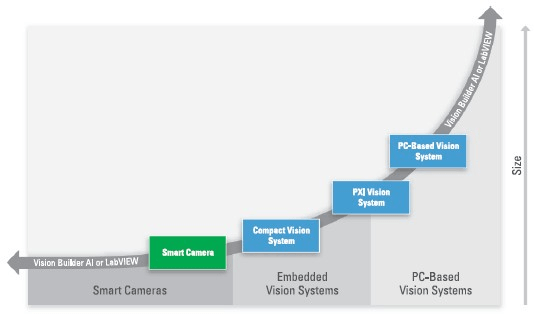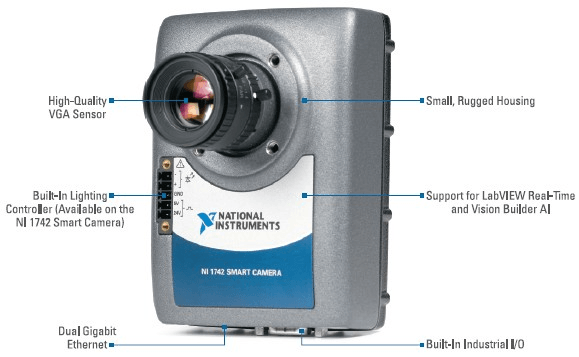Smart Cameras Information
 Smart cameras are individual image processing systems designed to automate decisions in an industrial capacity. These video cameras link an image sensor with a processing unit to determine the next desirable step of a mechanical process. They are smaller than PC-controlled machine vision systems and may not offer the same features or interface, and also operate with a ‘set-and-forget' mentality. Most smart cameras do not provide a video feed, but instead offer data based on the internal analysis.
Smart cameras are individual image processing systems designed to automate decisions in an industrial capacity. These video cameras link an image sensor with a processing unit to determine the next desirable step of a mechanical process. They are smaller than PC-controlled machine vision systems and may not offer the same features or interface, and also operate with a ‘set-and-forget' mentality. Most smart cameras do not provide a video feed, but instead offer data based on the internal analysis.
Smart cameras possess the unique capability of individually analyzing images and communicating this data with external industrial regulators and interfaces. This allows the automation of simpler processing decisions, and their small footprint and internal (and often very powerful) processors make them more flexible than machine vision sensors. Frequently, smart cameras are linescan instruments with exceptional one-line resolutions.

Smart cameras do not have a distinct appearance versus other camera types, but are rugged to maintain effectiveness in harsh environments. Without the need for particular imaging features, CCD and CMOS image sensors are common for smart cameras. Since a smart camera's imaging capabilities are seldom displayed, monochrome sensors are often satisfactory. Several smart cameras can be linked to create a unified vision system. Smart cameras incorporate important communication (e.g. Camera Link, GigE Vision, USB, FireWire) links to send data to industrial components and remote interfaces. Since smart cameras are implemented circumstantially, some development cost can be expected.
Video credit: DALSAMarcom1 / CC BY-SA 4.0
Specifications
Lens
As with other types of cameras, the lens plays a critical function in imaging quality. Lenses accurately refocus the field of view onto the small and sensitive image sensor, and also clear up any optical aberrations that occur. Camera lenses are marketed in standardized styles according to mounting.
C-mount lenses have a flange-back distance of 17.5 mm and are required for C-mount cameras. By comparison, CS-mount lenses have a flange-back distance of 12.5 mm. Because of their shorter back focal distance, CS-mount lenses cannot be used with C-mount cameras. C-mount features a diameter of 1" and a 32-thread per inch mounting thread.
CS-mount cameras can use both C-mount and CS-mount lenses; however, C-mount lenses require either a 5 mm adapter or adjustments to the CS-mount camera. Because of their shorter back focal distance, CS-mount lenses can be used only with CS-mount cameras. CS-mount features a diameter of 1" and a 32-thread per inch mounting thread.
S-mount is a smaller mounting configuration used in devices such as PC cameras and board-mounted cameras. S-mounts use a M12 x 0.5 threads.
An F-mount lens utilizes a bayonet-style mount standardized by Nikon.
 Resolution
Resolution
Resolution is the overall clarity of the image when displayed, as determined by the pixel count of the image sensor. For smart cameras, resolution ranges from 640 x 480 to 1600 x 1200 are most common. Linescan cameras have similar, one-line resolutions. In general, the lowest acceptable resolution should be used to keep camera processing manageable and quick.
Lighting
Many smart cameras have an integral strobe to ensure proper illumination. This also reduces wiring, additional hardware, and shortens imaging processing time, essential components with machine vision systems.
Frame Rate
Smart cameras have image capture rates of 25—35 frames per second, though many cameras have partial modes capable of capturing 100 frames per second. Frame rates should not exceed to computational abilities of the processor, but that is only relevant on older-model smart cameras as processors become more capable. Indeed, high speed smart cameras have prevalent.
Shutter Speed
This is responsible for the duration that light reaches the image sensor, and is usually controlled by an electronic shutter. It directly controls the exposure rate along with the aperture. Common smart cameras are programmable to have exposure times from 22 µm to 1,000 ms. This feature is largely dependent upon the requirements of the vision system's processes. Smart cameras with other exposure times, even those mimicking high speed cameras, are available.
Mounting
Many smart cameras incorporate mounting holes for brackets and extendable arm mounts. For brackets, typically two connection points are sufficient for proper positioning. Since smart cameras are not monitored by an operator, they almost never utilize handheld or portable frame designs. Dust, tampering, and moisture covers can extend the life of smart cameras.
Features
These specifications are often optional on video cameras, but depending upon the use they will enhance video quality.
|
|
|
|
|
|
|
|
|
|
|
|
|
|
|
Applications
Smart cameras are successful for non-contact measurement, product and processing inspection, quantifying, sorting and identification, code reading, robot input, and an otherwise endless list of employments. Due to their small size and ease of connectivity, sart cameras are only limited by the innovation of the operator. It is common to find smart cameras in automobile assembly, pharmaceutical processing, product and food packaging, quality control roles, and automated surveillance. Astonishingly, advanced security cameras can identify threats independently and alert authorities.
Video credit: Kleihorst / CC BY-SA 4.0
Resources
Wikipedia — Smart cameras; Machine vision systems
Machine Design — Smart programming for smart cameras
Keyence — Machine Vision Systems Products and Accessories
Image credit:
- 10 bits
- 12 bits
- 14 bits
- 16 bits
- 8 bits
- Anti-blooming
- Auto-Lens
- Board Mount
- Broadcast
- CCD
- CMOS
- Camera Link®
- Color
- Cooled Sensor
- Dome
- Ethernet
- Gain Control
- Gamma Correction
- High Definition
- IEEE 1394 (FireWire®)
- Industrial
- Machine Vision Sensor
- Monochrome
- NTSC
- Outdoor Rated
- PAL
- Pan / Tilt
- Progressive Scan
- RS232
- RS422
- RS485
- RS644 / LVDS
- Scientific / Research
- Security / Law Enforcement
- Smart Camera
- USB
- Underwater Rated
- Wireless
